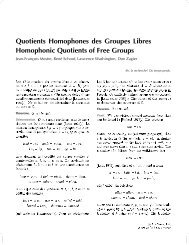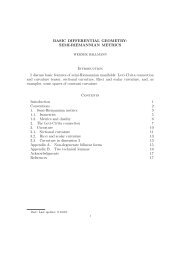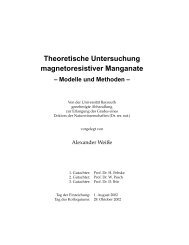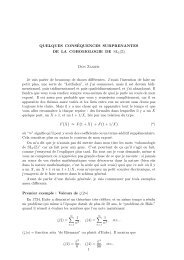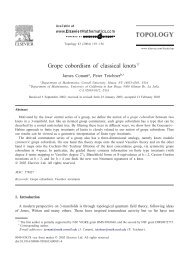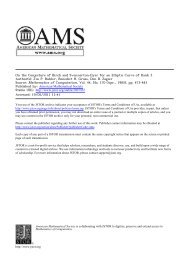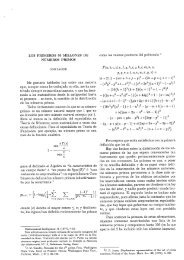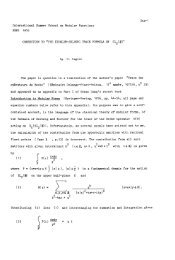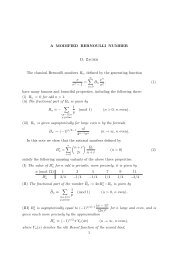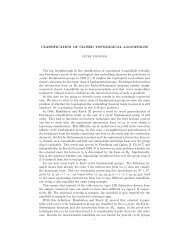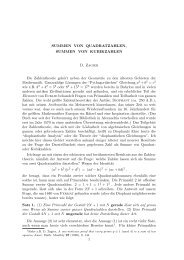48 D. Zagier5 <strong>Modular</strong> <strong>Forms</strong> <strong>and</strong> Differential OperatorsThe starting point for this section is the observation that the derivative ofa modular form is not modular, but nearly is. Specifically, if f is a modularform of weight k with the Fourier expansion (3), then by differentiating (2)we see that the derivativeDf = f ′ := 1 df2πi dz = q df∞ dq =∑na n q n (51)(where the factor 2πi has been included in order to preserve the rationalityproperties of the Fourier coefficients) satisfies( ) az + bf ′ cz + d= (cz + d) k+2 f ′ (z) + k2πi c (cz + d)k+1 f(z) . (52)If we had only the first term, then f ′ would be a modular form of weight k +2.The presence of the second term, far from being a problem, makes the theorymuch richer. <strong>To</strong> deal with it, we will:• modify the differentiation operator so that it preserves modularity;• make combinations of derivatives of modular forms which are again modular;• relax the notion of modularity to include functions satisfying equationslike (52);• differentiate with respect to t(z) rather than z itself, where t(z) is a modularfunction.These four approaches will be discussed in the four subsections 5.1–5.4, respectively.5.1 Derivatives of <strong>Modular</strong> <strong>Forms</strong>As already stated, the first approach is to introduce modifications of the operatorD which do preserve modularity. There are two ways to do this, oneholomorphic <strong>and</strong> one not. We begin with the holomorphic one. Comparingthe transformation equation (52) with equations (19) <strong>and</strong> (17), we find thatfor any modular form f ∈ M k (Γ 1 ) the functionn=1ϑ k f := f ′ − k 12 E 2 f, (53)sometimes called the Serre derivative, belongs to M k+2 (Γ 1 ). (We will oftendrop the subscript k, since it must always be the weight of the form to whichthe operator is applied.) A first consequence of this basic fact is the following.We introduce the ring ˜M ∗ (Γ 1 ):=M ∗ (Γ 1 )[E 2 ]=C[E 2 ,E 4 ,E 6 ], called the ringof quasimodular forms on SL(2, Z). (An intrinsic definition of the elements ofthis ring, <strong>and</strong> a definition for other groups Γ ⊂ G, will be given in the nextsubsection.) Then we have:
<strong>Elliptic</strong> <strong>Modular</strong> <strong>Forms</strong> <strong>and</strong> <strong>Their</strong> <strong>Applications</strong> 49Proposition 15. The ring ˜M ∗ (Γ 1 ) is closed under differentiation. Specifically,we haveE ′ 2 = E2 2 − E 412, E ′ 4 = E 2E 4 − E 63, E ′ 6 = E 2E 6 − E 2 42. (54)Proof. Clearly ϑE 4 <strong>and</strong> ϑE 6 , being holomorphic modular forms of weight 6<strong>and</strong> 8 on Γ 1 , respectively, must be proportional to E 6 <strong>and</strong> E4 2 , <strong>and</strong> by lookingat the first terms in their Fourier expansion we find that the factors are −1/3<strong>and</strong> −1/2. Similarly, by differentiating (19) we find the analogue of (53) forE 2 , namely that the function E 2 ′ − 1 12 E2 2 belongs to M 4(Γ ). It must thereforebe a multiple of E 4 , <strong>and</strong> by looking at the first term in the Fourier expansionone sees that the factor is −1/12 .Proposition 15, first discovered by Ramanujan, has many applications. We describetwo of them here. Another, in transcendence theory, will be mentionedin Section 6.♠ <strong>Modular</strong> <strong>Forms</strong> Satisfy Non-Linear Differential EquationsAn immediate consequence of Proposition 15 is the following:Proposition 16. Any modular form or quasi-modular form on Γ 1 satisfiesa non-linear third order differential equation with constant coefficients.Proof. Since the ring ˜M ∗ (Γ 1 ) has transcendence degree 3 <strong>and</strong> is closed underdifferentiation, the four functions f, f ′ , f ′′ <strong>and</strong> f ′′′ are algebraically dependentfor any f ∈ ˜M ∗ (Γ 1 ).As an example, by applying (54) several times we find that the functionE 2 satisfies the non-linear differential equation f ′′′ − ff ′′ + 3 2 f ′2 =0.Thisiscalled the Chazy equation <strong>and</strong> plays a role in the theory of Painlevé equations.We can now use modular/quasimodular ideas to describe a full set of solutionsof this equation. First, define a “modified slash operator” f ↦→ f‖ 2 g by(f‖ 2 g)(z) =(cz +d) −2 f ( )az+b +π cfor g = ( abcd).Thisisnotlinearinfcz+d12 cz+d(it is only affine), but it is nevertheless a group operation, as one checks easily,<strong>and</strong>, at least locally, it makes sense for any matrix ( abcd)∈ SL(2, C). Nowonechecks by a direct, though tedious, computation that Ch [ f‖ 2 g ] = Ch[f]| 8 g(where defined) for any g ∈ SL(2, C), where Ch[f] =f ′′′ − ff ′′ + 3 2 f ′2 . (Againthis is surprising, because the operator Ch is not linear.) Since E 2 is a solutionof Ch[f] =0, it follows that E 2 ‖ 2 g is a solution of the same equation(in g −1 H ⊂ P 1 (C)) for every g ∈ SL(2, C), <strong>and</strong> since E 2 ‖ 2 γ = E 2 for γ ∈ Γ 1<strong>and</strong> ‖ 2 is a group operation, it follows that this function depends only onthe class of g in Γ 1 \SL(2, C). ButΓ 1 \SL(2, C) is 3-dimensional <strong>and</strong> a thirdorderdifferential equation generically has a 3-dimensional solution space (thevalues of f, f ′ <strong>and</strong> f ′′ at a point determine all higher derivatives recursively



